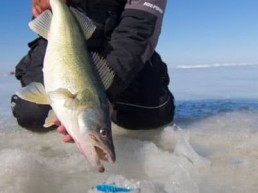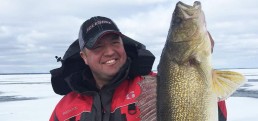Mille Lacs Lake: Q & A with Tony Roach
We recently connected with fishing guide and MidWest Outdoors TV contributor Tony Roach to discuss one of Minnesota’s top fisheries: Mille Lacs Lake. A top angling destination in all seasons, this 132,000-acre body of water offers a multi-species bonanza, and is a dynamic ice fishing lake.
MidWest Outdoors: Tony, how many years have you been fishing and guiding on Mille Lacs Lake?
Tony Roach: I’ve been guiding on Mille Lacs for going on 13 years now, and fishing the lake my whole life. I started fishing there at a very young age with my dad, and then got involved in tournament fishing as a teenager.
MWO: The Bassmaster Angler of the Year Championship was held on the lake in September. Tell us your impressions of having an Elite Series event scheduled on Mille Lacs with some of the top bass pros in the nation fishing your “home waters.”
Roach: It was really cool to see the nation’s top bass anglers on the lake and have the success they had. The catch-rates were fantastic and the average size of the bass was great. It’s been the best-kept secret in the bass world for a long time and it’s nice to see that showcased to the world. It’s going to bring a lot of new tourism dollars to the state—not just to Mille Lacs, but also to Minnesota, in general. We have a ton of great bass destinations here that are largely unheard of throughout the country and get overshadowed by other spots down south that get more attention. Minnesota, especially Mille Lacs, is a gold mine for bass fishing.
MWO: It’s ironic in a way that Mille Lacs has been known for decades as a world-class walleye fishery—traditionally one of the top lakes in the state—and it’s taken the exposure of a national B.A.S.S. tournament to open people’s eyes to what a phenomenal fishery this is. Lake Mille Lacs offers “The Fantastic Four” species, with trophy potential for each—walleyes, smallmouths, muskellunge and northern pike.
Roach: There are a lot of Midwest locations you can visit and catch fish, but Mille Lacs is a destination where you can catch BIG fish. Walleyes, smallmouth bass, muskies, northern pike, jumbo perch—it truly is a trophy fishery. Don’t forget there are largemouths and some huge crappies and bluegills in the shallow, weedy bays. During the Elite Series event, so many of the pros commented on how many big fish they caught—not just the monster bass, but lots of big walleyes, huge northerns and even a few muskies. And, that’s with guys mostly fishing light-line artificials like drop-shot rigs and creature baits. Being a guide on Mille Lacs, I see this lake’s potential every single day I’m out there—just the amazing size structure of the species in the lake. Lots of numbers, lots of size—as a fisherman you can’t ask for anything more!
MWO: Talk about the walleye population specifically. There are a variety of opinions out there regarding the overall health of the fishery with walleyes. And because you’re out on the lake so many days each year you are basically taking a daily creel census with hook-and-line that provides an accurate measurement of what’s going on. And, you’re also a member of the Mille Lacs Lake Fisheries Advisory Committee.
Roach: First off, we’re catching lots of walleyes. The biggest misconception regarding the restrictive limits is that there are no walleyes in Mille Lacs, and that couldn’t be further from the truth. What the MNDNR has been trying to do is protect the spawning biomass in the lake because they are worried about “recruitment”—the survival rate of the young-of-the-year walleyes coming up. They were worried about too many large gaps in year-classes. Historically, the Mille Lacs walleye harvest has been focused on those younger fish—walleyes less than 18 inches. Combining poor recruitment with overharvest can result in too few walleyes reaching sexual maturity. The fish have to reach adulthood so they can in turn reproduce and sustain the health of the walleye population.
MWO: What’s the exact numbers for the current status of the walleyes, based on your experience?
Roach: Right now, we have an absolutely unbelievable class of the 2013 fish; they are all over the lake, wherever you fish. They range in size from 14-17 inches. Plus, you have an abundance of big walleyes in the lake, plenty of mid- to high-20-inch fish. These fish currently are not getting harvested due to restrictive limits and closed seasons, but the numbers of fish you catch is amazing—and so fun. It’s fantastic! It’s not out of the realm to go out and average 50-plus fish in a day.
MWO: The fall bite has been excellent this year. The remarkable thing is that the lake has been “closed” to walleye fishing for several months. Incredible numbers of walleyes are being caught using artificial lures meant to target bass. Imagine the scale of the action if live bat and “walleye-specific” techniques had been permitted this fall. Do you use the fall bite as a barometer for how the upcoming ice fishing season will go?
Roach: Yes. The fishing has been nuts without even trying. Fall fishing is always my barometer for how the ice fishing season is going to go. If it’s a great fall bite, in most years, that continues right into ice-up and beyond. I’m seeing one of the best fall bites of the past six or seven seasons. As I said, that 2013 year-class is out there in big-time numbers, and those 14- to 17-inch fish generally are aggressive biters through the ice. In the early ice season, expect to catch a ton of fish in that size range as well as those bigger walleyes mixed in.
MWO: Talk about that early-ice period. Where are some of your key locations for depth and type of structure?
Roach: I tend to start in shallow water right at the start of the season. For sure, during those peak morning and evening periods I want to be set up on the shallow breaks, on structure less than 19 or 20 feet. That being said, Mille Lacs is somewhat unique in that there is a good, daylong bite for walleyes, which is unusual for such clear water. But if you target the main-lake mudflats or the deep gravel bars during daytime, you’ll catch good numbers of walleyes in those spots, too. I’ll punch a lot of holes in those deeper basin areas with my StrikeMaster, say in 25-30 feet of water, and keep moving to find fish that are willing to bite. Then, as evening approaches, I’ll return to the shallow shoreline breaks to catch walleyes as they get aggressive at dusk. Mille Lacs’ walleyes move a lot, especially at early ice.
MWO: Review how you rig up for the Mille Lacs walleyes.
Roach: I fish 27- to 36-inch rods—my Tony Roach Series ice rods (manufactured by Wright & McGill). I like a light, spinning combo with a medium tip. I do a lot of spoon fishing and a lot of jig fishing so it’s important to fish a rod with a sensitive tip to add action to the lure. It needs to have plenty of backbone so you can set the hook effectively, even with a small lure. Most ice spoons have small, light wire treble hooks and you need a rod that will deliver a punch in your hook-set to drive the hook into the fish’s mouth. For most of the season I spool up with 6-pound monofilament line for my hole-hopping rod. I’m on the move constantly, and the rod is exposed to the cold, and, mono prevents freeze-up. Sometimes I also roam with a braid rod and a fluorocarbon leader when weather conditions are mild or I’m hunkered down in the Otters. Just be sure to use good, quality reels with good drag systems. It’s easy to snap off big fish on 6-pound-test if your drag isn’t set right, so just be sure to use quality reels with good drag systems on all your rods.
MWO: Talk about your favorite lures.
Roach: I fish a lot of Northland Tackle Buck Shot spoons and Macho Minnows and Jigging Rapalas. For the early-ice period, I like lures that have a more aggressive action—ones that dart in the water column more than subtle lures. The fish are more aggressive in early ice; they’re chasing the remaining young-of-the-year perch and shiners that have survived through fall. Flutter spoons have that extra kick. They fall at a different rate, they give off a lot of flash and they trigger bites. Buck Shot Flutter Spoons, Macho Minnows and Jigging Rapalas are my go-to lures. The spoons have a split ring for the line-tie. Having that extra twist gives those lures a lot more action when jigged, as opposed to spoons where you tie directly to the eyelet. And Jigging Raps, of course, as they just dart all over the place and perfectly resemble small minnows.
MWO: Do you stick with lures like this throughout the season?
Roach: No. Later in winter I go away from spoons with that split ring. Instead, I tie directly to the eyelet and end up fishing the lure more vertically, with less of a darting action. Once the minnow forage has been wiped out in midwinter, walleyes and perch start keying on invertebrates and a subtle spoon more closely imitates the action I want. I can pound the silt with these spoons and create a disturbance in the mud, imitating larvae. Plus, the fish aren’t as aggressive later in winter; they don’t chase baits as much and their activity levels are down. To compensate, my jigging cadence is much less aggressive compared to early ice, when I’m really snapping those spoons and giving them a ton of action in the water. And, of course, I’m watching the fish react on my Marcum so I adjust the way the lure is presented to keep them interested and biting based on what my electronics are telling me.
MWO: Give us an update on the perch population.
Roach: The perch population has really been down these past few seasons. We do catch some real giants—I’m talking fish that are 13, 14 and even 15 inches. But we’re just not seeing big-time numbers of those perch like we were a few years ago. I think we’re getting back to a consistently catchable perch population this year, but it’s just not as good as it was back in the day—it’s cyclical.
MWO: Why should MidWest Outdoors readers come to Mille Lacs this winter?
Roach: The walleye catch-rates on Mille Lacs are going to be out of this world this winter; the catch-rates will rival any Midwest-walleye destination. When you combine the numbers of fish along with the big ones in the system, it’s going to be a banner year. The fact that you can catch walleyes at any hour of the day or night is a huge bonus as well. Throw in some jumbo perch and the bonus tullibees (ciscoes) and you have the makings for some really fun times on the ice.
MWO
SHARE THIS POST
Did you enjoy this post?
You can be among the first to get the latest info on where to go, what to use and how to use it!




